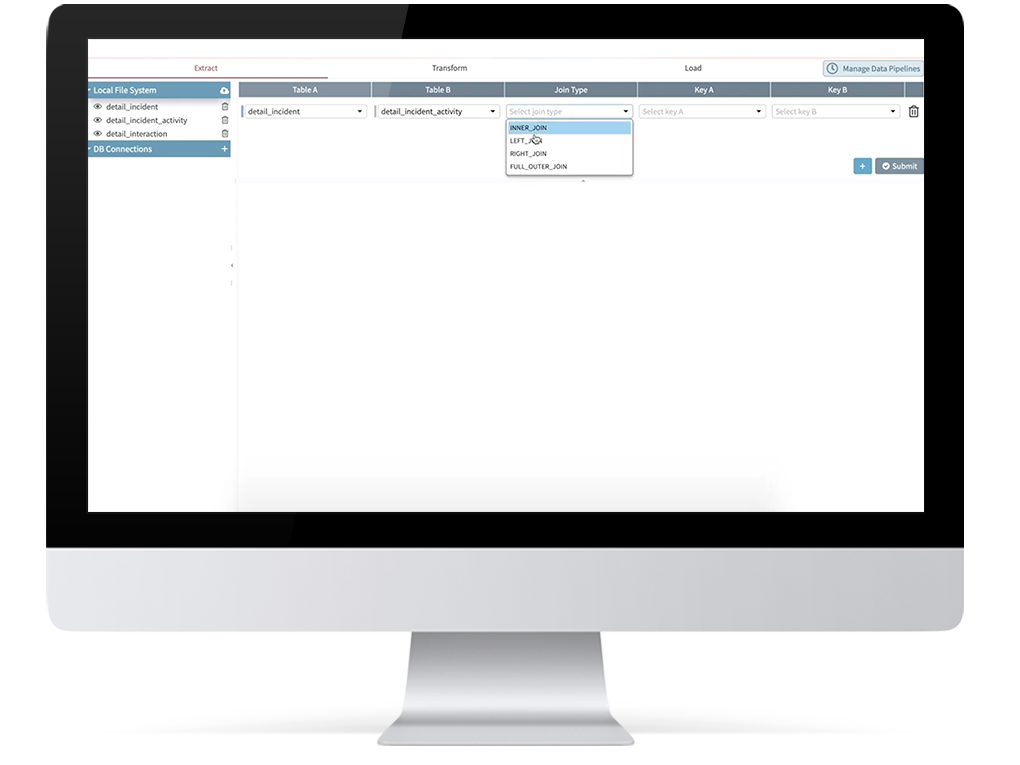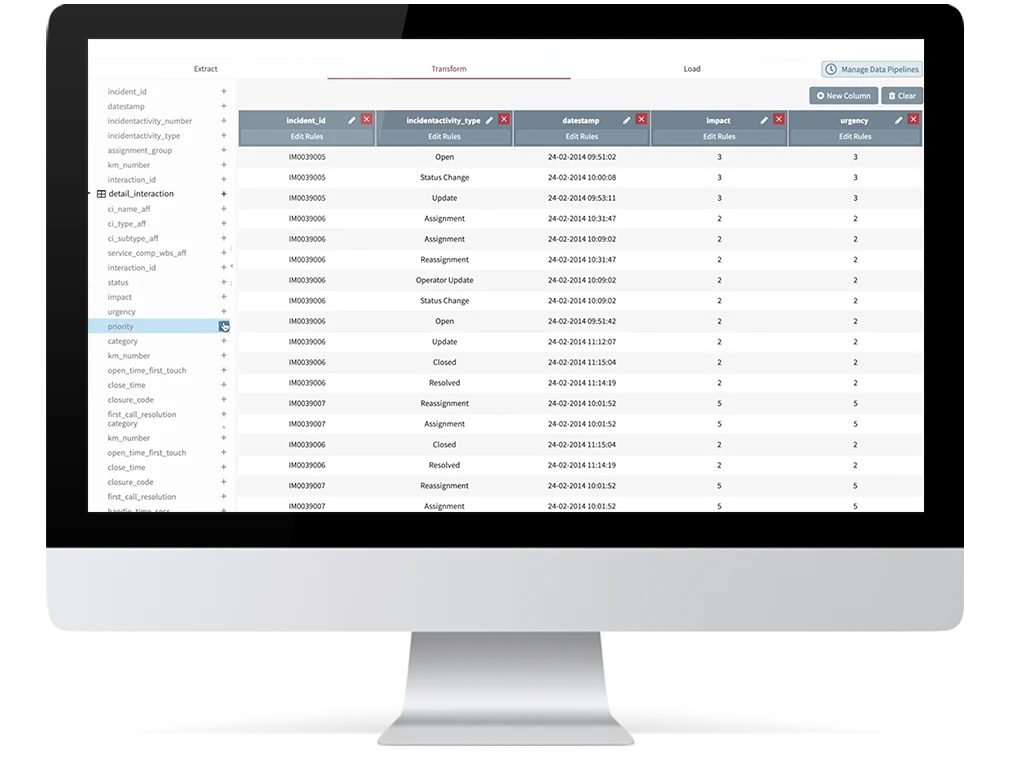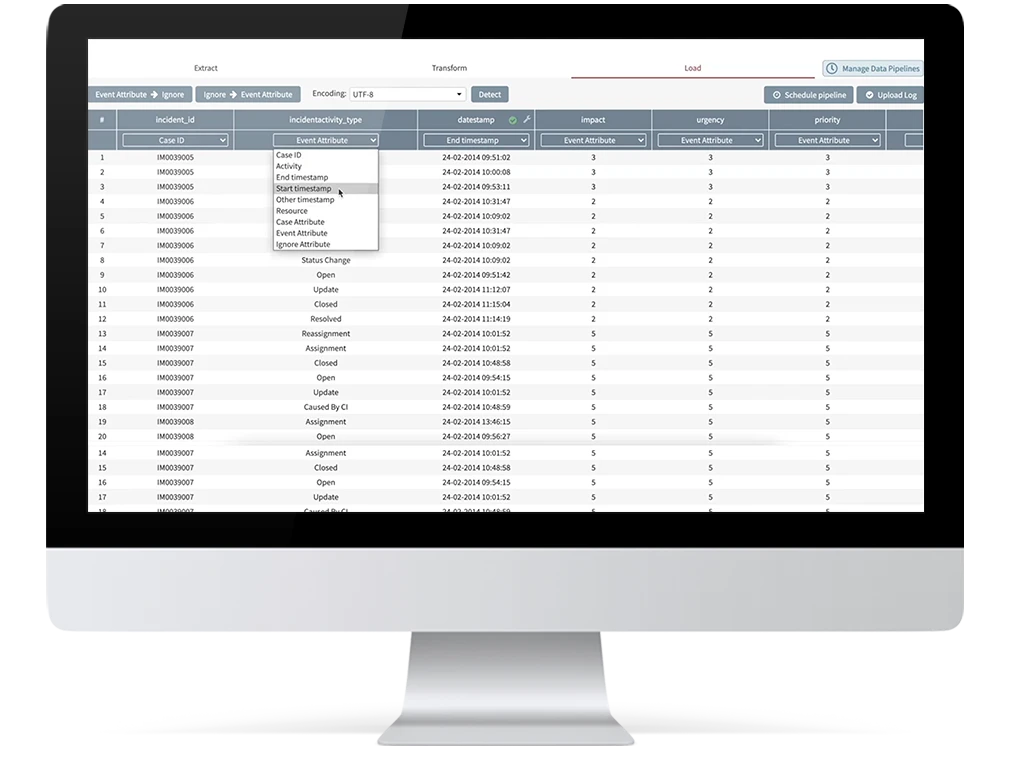BIC Process Design
Understand & Transform
Supercharge your business operations with the most intuitive AI-powered BPM software.
It seems that you come from a German speaking country. Here you can change the language
EnglishExtract, Transform, Load describes a process in which data from an unlimited number of sources is collected, prepared, and centrally merged into a single repository. The goal of this process is to prepare the data for subsequent analyses and applications to enable data-driven decisions. BIC Process Mining not only provides groundbreaking analyses, but also makes the process of data preparation and processing particularly simple - for even faster results.

Today, many companies obtain their data from different internal and external sources instead from a central system. Retrieving targeted information is therefore difficult to realize and often leads to errors, since the different data bases often provide different results. The ETL process in BIC Process Mining captures this data from the different sources, organizes it and loads it bundled into a database. These actions are performed in three steps and are divided into extraction, transformation and loading of the data. The ETL function thus allows you to compile event logs from one or more tables or data sources. In this way, you gain detailed insight into the totality of your collected data and can evaluate it more effectively. You can then use these insights to make data-based decisions within your organization. The ETL process is particularly useful for processing large amounts of data in areas such as Business Intelligence or Big Data.

In order to unite and subsequently prepare the company-relevant data from several sources, they are transformed into management-relevant information in three steps using targeted actions.

Extract: Filtering out the data
The first step in the ETL process is to extract the relevant data from the various source systems. To do this, all important data in the systems is first selected and prepared for the subsequent transformation process. Usually, only a section of the source data is extracted during this process of filtering out the data. The sources can come from different information systems and consist of different data formats and structures.

Transform: Transformation of the data
In the next step, data transformation, the source data selected in the previous step is adapted to the required target schema. Since they may come from differently structured sources and have different value ranges, they must be transformed into a uniform data schema. The transformation stage of ETL also allows renaming of certain activities and thus provides full flexibility with the unique transformation rules.

Load: Providing the data
The last step consists of loading the checked data. This involves integrating the prepared data from the workspace into a database. For this purpose, they are physically moved into the database and data analysis systems based on them are updated. Instead of a one-time upload, it is also possible to schedule the upload on an hourly, daily, weekly or monthly basis. For example, a weekly schedule can be set for a specific day and time.
The large accumulations of data that often accompany digitalization are usually difficult for companies to organize. They often use a variety of tools instead of executing an end-to-end process in a central system. As a result, potential remains untapped and resources are wasted. Market research specialist Gartner writes in its Market Guide for Process Mining 2020 that "extensive and expensive business processes underpinned by a patchwork of technologies that are often not optimized, lean, interconnected and consistent need to be explicitly visualized." According to Gartner, this would "deliver a path to digital excellence that addresses the enormous collective debt within enterprises." Implementing an ETL process is recommended whenever an organization wants to make informed management decisions and needs access to data from disparate sources to do so.
If the data queries are difficult to implement with the existing resources in the company, the introduction of ETL makes sense. By combining data from different sources with the ETL function included in BIC Process Mining, for example a table from SAP data and a table from a CRM system, you can create comprehensive and meaningful analyses. By combining such different tables, hidden inefficiencies can thus be made visible and optimized through the use of patchwork technologies.
Best of all, ETL is a no-code solution that allows you to create insightful analyses without programming skills. In addition, our connector BIC Process Mining for SAP provides you with an optimal interface between your SAP solution and BIC Process Mining - ensuring increased performance, innovation and operational excellence.
ETL brings together business-relevant data from a variety of sources and helps you to gain a better overview - and as a result, usually to make better decisions that have a revenue-boosting effect on your business. At the same time, increasing growth requires optimization or expansion of the technologies used, which means that the IT landscape becomes more complex. While integrating more useful applications helps improve the quality and scalability of your company's services, it also makes decision-making at the operational and strategic levels increasingly difficult. ETL allows you to aggregate the unmanageable amount of data and use it profitably to align your business.

The ETL function in BIC Process Mining is an essential part of modern business intelligence processes. In addition to the ability to compile event logs from one or more tables or data sources, the function offers many other benefits for companies - all without programming knowledge.
The advantages of the ETL function with BIC Process Mining:
Because you can only optimize the processes you are aware of: with BIC you will discover the true potential of data-based BPM in your organization. Learn more about how process mining can positively influence your business success.